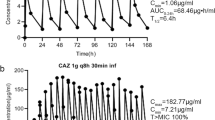Abstract
With increasing multidrug resistance coupled to a poor development pipeline, clinicians are exploring antimicrobial combinations to improve treatment outcomes. In vitro hollow-fiber infection model (HFIM) is employed to simulate human in vivo drug clearance and investigate pharmacodynamic synergism of antibiotics. Our overarching aim was to optimize the HFIM-based pharmacokinetic (PK) assay by using rifampicin and polymyxin B as probe drugs. An ultrapressure liquid chromatography tandem mass spectrometry method was validated for the quantification of rifampicin and polymyxin B components. In vitro profiling studies demonstrated that the experimental PK profiles of polymyxin B monotherapy were well correlated with the human population PK data while monotherapy with rifampicin failed to achieve the expected maximum plasma concentration. Chemical stability studies confirmed polymyxin B was stable in broth at 37 °C up to 12 h while rifampicin was unstable under the same conditions over 12 and 80 h. The calculated mean clearance of rifampicin due to chemical degradation was 0.098 ml/min accounting for 12.2 % of its clinical total clearance (CL = 0.8 ml/min) based on population PK data. Our novel finding reinforces the importance to optimize HFIM-based PK assay by performing chemical stability study so as to account for potential discrepancy between experimental and population PK profiles of antimicrobial agents.

Optimizing hollow-fiber-based pharmacokinetic assay





Similar content being viewed by others
References
Peleg AY, Seifert H, Paterson DL (2008) Acinetobacter baumannii: emergence of a successful pathogen. Clin Microbiol Rev 21:538–582
Talbot GH, Bradley J, Edwards JE, Gilbert D, Scheld M, Bartlett JG (2006) Bad bugs need drugs: an update on the development pipeline from the Antimicrobial Availability Task Force of the Infectious Diseases Society of America. Clin Infect Dis 42:657–668
Evans ME, Feola DJ, Rapp RP (1999) Polymyxin B sulfate and colistin: old antibiotics for emerging multiresistant gram-negative bacteria. Ann Pharmacother 33:960–967
Li J, Rayner CR, Nation RL, Owen RJ, Spelman D, Tan KE, Liolios L (2006) Heteroresistance to colistin in multidrug-resistant Acinetobacter baumannii. Antimicrob Agents Chemother 50:2946–2950
Rahal JJ (2006) Novel antibiotic combinations against infections with almost completely resistant Pseudomonas aeruginosa and Acinetobacter species. Clin Infect Dis 43(Supplement 2):S95–S99
Lim TP, Tan TY, Lee W, Suranthran S, Tan TT, Hsu LY, Kwa AL (2009) In vitro activity of various combinations of antimicrobials against carbapenem-resistant Acinetobacter species in Singapore. J Antibiot (Tokyo) 62:675–679
Zavascki AP, Goldani LZ, Li J, Nation RL (2007) Polymyxin B for the treatment of multidrug-resistant pathogens: a critical review. J Antimicrob Chemother 60:1206–1215
Orwa JA, Govaerts C, Busson R, Roets E, Van Schepdael A, Hoogmartens J (2001) Isolation and structural characterization of polymyxin B components. J Chromatogr A 912:369–373
Govaerts C, Orwa J, Van Schepdael A, Roets E, Hoogmartens J (2002) Characterization of polypeptide antibiotics of the polymyxin series by liquid chromatography electrospray ionization ion trap tandem mass spectrometry. J Pept Sci 8:45–55
Gumbo T, Louie A, Deziel MR, Liu W, Parsons LM, Salfinger M, Drusano GL (2007) Concentration-dependent Mycobacterium tuberculosis killing and prevention of resistance by rifampin. Antimicrob Agents Chemother 51:3781–3788
Zavascki AP, Goldani LZ, Cao G, Superti SV, Lutz L, Barta AL, Ramos F, Boniatti MM, Nation RL, Li J (2008) Pharmacokinetics of intravenous polymyxin B in critically ill patients. Clin Infect Dis 47:1298–1304
D’Argenio DZ, Schumitzky A (1997) ADAPT II user’s guide: pharmacokinetic pharmacodynamic systems analysis software. Biomedical simulations resource, University of Southern California, Los Angeles
He J, Figueroa DA, Lim TP, Chow DS, Tam VH (2010) Stability of polymyxin B sulfate diluted in 0.9 % sodium chloride injection and stored at 4 or 25 degrees C. Am J Health Syst Pharm 67:1191–1194
He J, Ledesma KR, Lam WY, Figueroa DA, Lim TP, Chow DS, Tam VH (2010) Variability of polymyxin B major components in commercial formulations. Int J Antimicrob Agents 35:308–310
Kwa AL, Abdelraouf K, Low JG, Tam VH (2011) Pharmacokinetics of polymyxin B in a patient with renal insufficiency: a case report. Clin Infect Dis 52:1280–1281
Govaerts C, Rozenski J, Orwa J, Roets E, Van Schepdael A, Hoogmartens J (2002) Mass spectrometric fragmentation of cyclic peptides belonging to the polymyxin and colistin antibiotics studied by ion trap and quadrupole/orthogonal-acceleration time-of-flight technology. Rapid Commun Mass Spectrom 16:823–833
Tam VH, Cao H, Ledesma KR, Hu M (2011) In vitro potency of various polymyxin B components. Antimicrob Agents Chemother 55:4490–4491
New LS, Saha S, Ong MM, Boelsterli UA, Chan EC (2007) Pharmacokinetic study of intraperitoneally administered troglitazone in mice using ultra-performance liquid chromatography/tandem mass spectrometry. Rapid Commun Mass Spectrom 21:982–988
Balbão MS, Bertucci C, Bergamaschi MM, Queiroz RH, Malfará WR, Dreossi SA, de Paula ML, Queiroz ME (2010) Rifampicin determination in plasma by stir bar-sorptive extraction and liquid chromatography. J Pharm Biomed Anal 51:1078–1083
Kenny MT, Strates B (1981) Metabolism and pharmacokinetics of the antibiotic rifampin. Drug Metab Rev 12:159–218
Acknowledgments
This work was supported by the SingHealth Foundation Grant SHF/FG399P/2008 provided to T.P.L. and A.L.H.K. and the NUS Academic Research Fund (AcRF) Tier 1 Grant R-148-000-135-112 provided to E.C.Y.C.
Author information
Authors and Affiliations
Corresponding author
Rights and permissions
About this article
Cite this article
New, L.S., Lim, T.P., Oh, J.W. et al. Optimizing hollow-fiber-based pharmacokinetic assay via chemical stability study to account for inaccurate simulated drug clearance of rifampicin. Anal Bioanal Chem 405, 1407–1415 (2013). https://doi.org/10.1007/s00216-012-6549-7
Received:
Revised:
Accepted:
Published:
Issue Date:
DOI: https://doi.org/10.1007/s00216-012-6549-7




